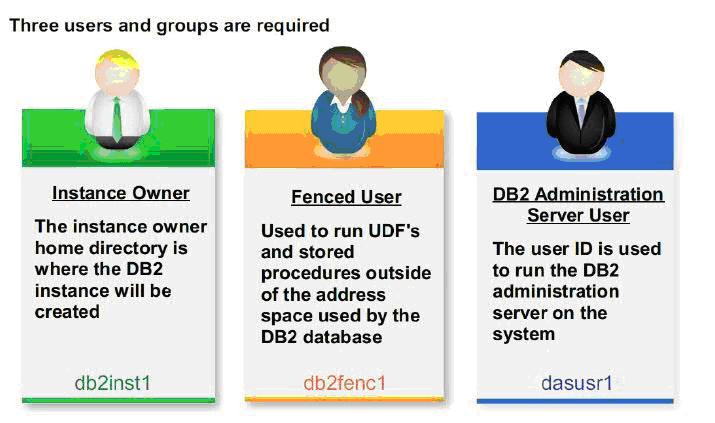-
Instance owner
- The DB2 instance is created in the instance owner home directory.
- This user ID controls all DB2 processes and owns all filesystems and devices used by the databases contained within the instance.
- The default user isdb2inst1and the default group isdb2iadm1.
- The fenced user is used to run user defined functions (UDFs) and stored procedures outside of the address space used by the DB2 database.
- The default user isdb2fenc1and the default group isdb2fadm1.
- The user ID for the DB2 administration server user is used to run the DB2 administration server (DAS) on your system.
- The default user isdasusr1and the default group isdasadm1.
- This user ID is also used by the DB2 GUI tools to perform administration tasks against the local server database instances and databases.
- There is only one DAS per computer. One DAS services one or more database instances, including database instances that belong to different installations.
- The DAS release level must be as high (or higher) than the release level of any of the database instances it services.
Default users and groups |
||
| User | Example user name | Example group name |
| Instance owner | db2inst1 | db2iadm1 |
| Fenced user | db2fenc1 | db2fadm1 |
| DB2 administration server user | dasusr1 | dasadm1 |
Procedure to create uses and groups
To create the required groups and user IDs for DB2 database systems:- Log in as a user with root user authority.
- Enter the following commands for the Linux operating systems
#groupadd -g 999 db2iadm1
#groupadd -g 998 db2fadm1
#groupadd -g 997 dasadm1
Ensure that the group-id are not in use, we could use any available group-id
b) Create users for each group:
#useradd -u 1004 -g db2iadm1 -m -d /home/db2inst1 db2inst1
#useradd -u 1003 -g db2fadm1 -m -d /home/db2fenc1 db2fenc1
#useradd -u 1002 -g dasadm1 -m -d /home/dasusr1 dasusr1
Ensure that the user-id are not in use, we could use any available user-id
c) Set initial password:
passwd db2inst1
passwd db2fenc1
passwd dasusr1
